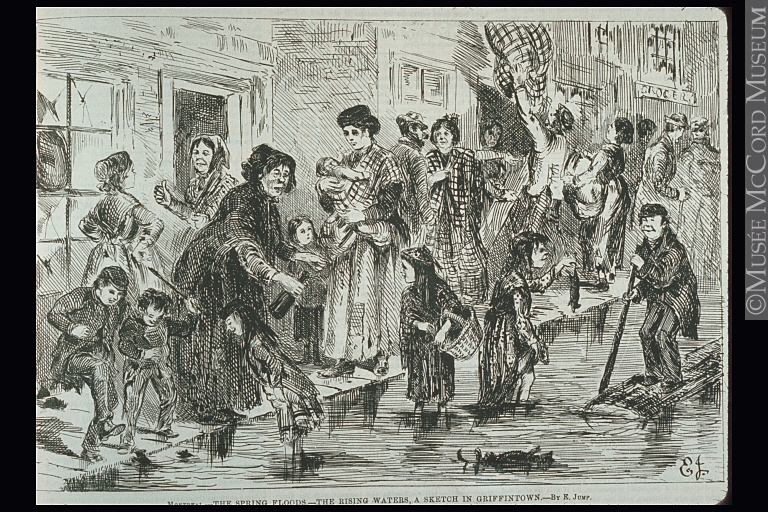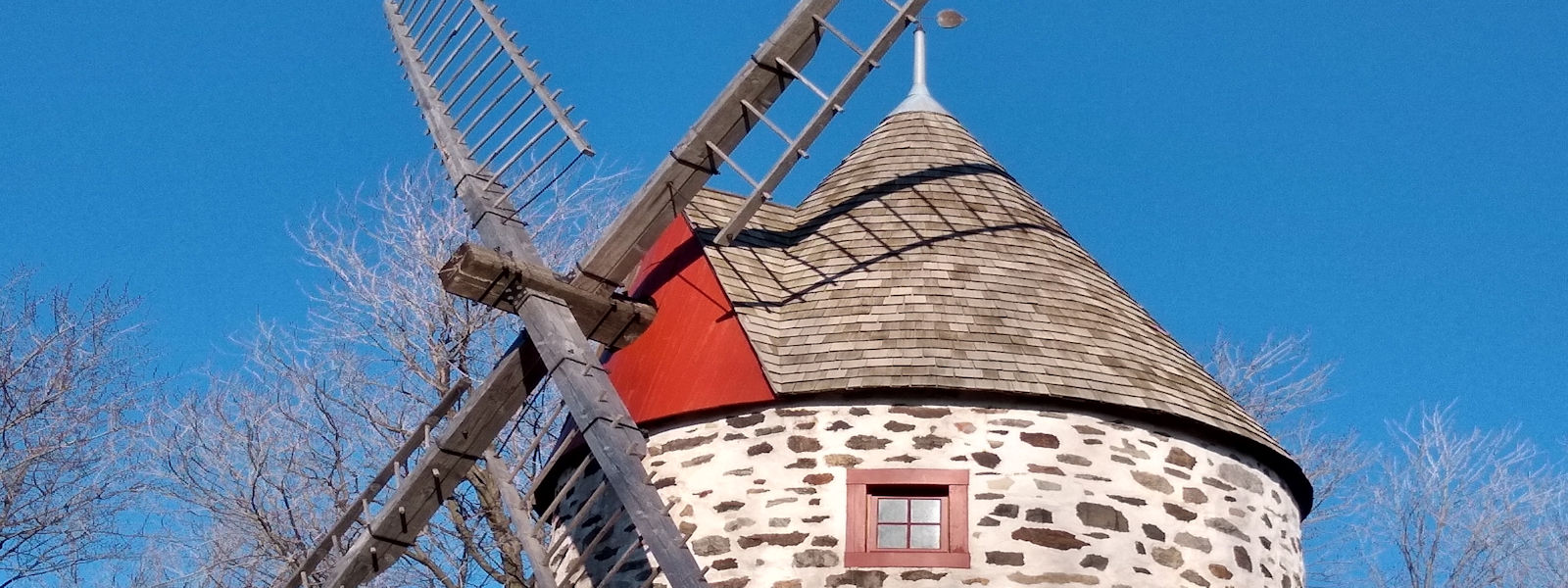
Mary Gallagher was brutally murdered on June 27th, 1879 in Montreal’s Griffintown neigbourhood. It is said that every 7 years, her ghost returns to the corner of William and Murray Streets in search of her head !
Event: the murder, beheading and dismemberment of Mary Gallagher.
When: the afternoon of June 27th, 1879.
Where: at 242 William Street in the Griffintown neighbourhood of Montreal.
(242 William Street was a dilapidated multi- story dwelling, owned by James Hartford (a carter by trade).Susan Kennedy and her husband lived on the top floor (where the murder was committed) and on the ground floor lived the Troy family.
Why: the combination of hopelessness, three bottles of whiskey, and an axe.
Mary Gallagher Connolly: separated from husband, fell into prostitution later in life due to misfortunes, 38 years of age, body was interred in Cote-des-Neiges Cemetery.
Susan Kennedy Myers: a prostitute and described as a “tall strapping Irish woman, possesing great physical power”, 26 years of age and originally from Leeds, Ontario. Found guilty of the brutal killing of Mary Gallagher. Received a life sentence and died at Kingston Penitentiary.
Jacob Meyers (also spelled as Myers and Mears): husband of Susan Kennedy for 5 or 6 years, born in Ireland, 30 years old, occupation as “a-man-of-all-work” and employed at Mr. Clendinneng’s workshop.
James Conolly: husband of Mary Gallagher, a maltster in the Montreal Brewing Company, had not seen his wife in two years.
Michael Flanagan:had met Mary Gallagher at the wharf the night before and they went to a hotel together before going to 242 William the next morning. Flanagan claims he left the next day after the whiskey was consumed.
Police: Chief Paradis, High Constable Bissonette, Detective Cullen, Sergent Clancy, Constable McKinnon, Constable Riley, Constable Angers, Sub-Constable McCormick, Sub-Constable Carrig
Police station: east side of Young Street (formerly Kempt Street), between Ottawa Street and Wellington Street.
Susan Kennedy, Micheel Flannagan and Jacob Myers(Mears) all arrested for murder of Mary Gallagher.
Inquest witnesses:Mrs. Hartford (244 William Street), Catherine Walch (243 William Street), John Regan (464 William Street), John King (91 Ottawa Street), James Hartford (owner of 242 William and resides at 244 William Street)
Dr. J.J.E. Guerin: doctor who inspected body of Mary Gallagher and gave examination report during the inquest.
Inquest members: John Bailey (foreman), W.J. Rafferty, John Walker, Henry Walsh, James Cloran, D. Gosling, Ant. Deguire, Charles Finnagin, Thomas Connaughton, John Rodgers, Thomas Smith, David Ralston, Jno. O’Brien, Joseph McPherson.
Inquest concludes on July 7, 1879: Susan Kennedy, Jacob Mears and Michael Flanagan found guilty of “feloniously, willfully, and of their malice aforethought, kill and murder Mary Gallagher.”
Lawyers representing Susan Kennedy at trial in October, 1879: Mr. Macmaster and Mr. Greenshields
Crown prosecutor: Mr Devlin
Coroner: Jos. Jones
Trial Jury: Thomas Lawlor, Patrick Kelly, James Coghlan, James Walsh, William King, Thomas Adcock, John D. Bennett, Duncan Campbell, Edouard Henkill, Edward Lynch, Edward Nulty and William Gibson.
Trial witnesses:Catherine McCarty,Jacob Mears,Helen Burke,Rev. Father Lauzon,Dr. John William Mount, James Flanagan, John Monaghan, Patrick Madigan, Margaret Curran
Trial concludes October 1st, 1879: Defense tried to get a dismissal by insanity . Jury returned a verdict of “Guilty” by 6pm.
Susan Kennedy was sentenced on October 2nd to be hanged on December 5, 1879.
Michael Flanagan and Jacob Mears found “Not Guilty” on October 3rd, 1879.
November 10th, 1879, death sentence commuted to life imprisonment.
November 29th, 1879, Susan Kennedy removed from St. Vincent de Paul penitentiary due to overcrowding and escorted to the Kingston Penitentiary.
Twist of fate: on the day that Susan Kennedy was originally sentenced to be hanged (Dec.5), Michael Flanagan slipped and fell into the Wellington Basin and drowned. He had been working and stowing barges for the winter. His body disappeared under the ice. Some say he threw himself into the canal and committed suicide.
Susan Kennedy died of consumption in Kingston penitentiary some eleven years later on September 29, 1890. She was buried in the prison’s cemetery.
Google map today showing location of Griffintown
Map of Montreal showing St. Ann’s Ward (Lovell’s Montreal Directory 1897)
The red star marks the corner of William and Murray streets and the blue star marks the police station on Young Street


Canadian Illustrated News (July 12, 1879) showing 242 William Street

Possible location of 242 William Street near Murray Street (photo taken 2019)

Looking south on Murray from corner of William (photo taken 2019)

Police Station on Young Street – this is the orginal building built in 1875 (photo taken 2019)

Griffintown in the 1870’s was a world of itself.
Below images help us understand this a little more, with thanks to McCord Museum Collections
Print | Montreal – The Spring Floods – The Rising Water, a Sketch in Griffintown | M985.230.5356

| Messrs Clendinning’s Foundry-Moulding Shop | M979.87.5024

| Montreal – R. Gardner & Sons’ Novelty Works on Nazareth and Brennan Streets | M979.87.366

The following images courtesy of BANQ – Bibliothèque et Archives nationales du Québec
Griffintown flooding

Clendinneng factory – William Street

Clendinneng foundry – exterior on William Street

corner of Young and Ottawa streets – Griffintown

corner of William and Richmond streets – Griffintown

The next two images compare the two world’s in Montreal at the time.
The poverty and hopelessness in contrast to the very affluent.
The first image details how police found a family in tatters where two children froze to death in their dwelling on Kempt Street (Griffintown) in January 1872.
The second image is that of the Allen family home (Andrew Allen of the shipping empire) and it’s opulence.
Print |

Photograph | Andrew Allan’s family in drawingroom, 1871 | I-64582.1

St-Ann’s Church – pre-1900’s before it had a spire

Back to Top
















































































































































































